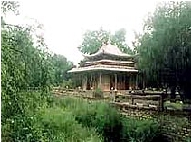 Lhasa means “sacred land” in Tibetan, and Potala Palace, the architectural wonder in the center of Lhasa, is the symbol of that sacred land. When the thirty-third King of Tibet, Songtsan Gampo, was married in 641 to Princess Wen Cheng of the Tang Dynastry, he had 999 houses built on Hongshan Hill for his bride, as well as the red building at the top of the hill. The Buddhists later named it Potala Palace, meaning the sacred land of Buddhism. Lhasa means “sacred land” in Tibetan, and Potala Palace, the architectural wonder in the center of Lhasa, is the symbol of that sacred land. When the thirty-third King of Tibet, Songtsan Gampo, was married in 641 to Princess Wen Cheng of the Tang Dynastry, he had 999 houses built on Hongshan Hill for his bride, as well as the red building at the top of the hill. The Buddhists later named it Potala Palace, meaning the sacred land of Buddhism.
Ravaged by lightning, fire, and war, the original palace was severely damaged. In the restored palace we see today, the white buildings on either side, called the White Palace was built three hundred years ago by the Fifth Dalai Lama as living quarters. The central building, called the Red Palace, was built by the disciple of the fifth Dalai Lama and contains mourning halls and libraries.
Potala Palace was constructed on the hillside. Surrounded by a wall three metres high, the thirteen-story palace is 110 metres tall and has over ten thousand pillars; its 90,000 square metres of floor space was built on an area of 102,880 square metres.
Sunlight Hall in Potala Palace is flooded with sunlight throught the year. Eastern Sunlight Hall was the residence of the Thirteenth Dalai Lama, and Western Sunlight Hall was the one for the Fourteenth Dalai Lama. Now these luxurious halls house valuable pearls, jewels, and antiques.
Mural art is an intrinsic part of the architecture of Potala Palace. Every room, no matter how small, is decorated with colourful, vivid murals. The 698 murals along the painted second floor corridor are the most extraordinary, depicting Buddhist stories and the unique scenery, customs, and legends of ancient Tibet.
|